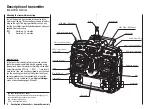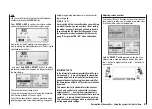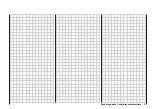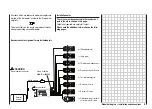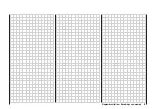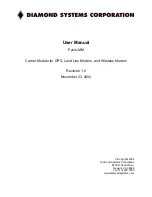
23
Using the receiving system for the fi rst time
Installation notes
Your receiving system must be installed correctly in the
model. The following are a few suggestions when using
GRAUPNER
equipment:
1. Wrap the receiver in (anti-static) foam rubber at least
6 mm thick. Fix the foam round the receiver using
rubber bands, to protect it from vibration, hard lan-
dings and crash damage.
2. The receiver aerial must be secured in the model, so
that there is no chance of it becoming tangled in the
propeller or control surfaces. However, it is best not
to deploy the aerial in an exactly straight line, but to
angle it: e.g. run it straight to the tailplane, then lea-
ve the fi nal 10 - 15 cm trailing freely, as this avoids
reception “blind spots” when the model is in the air. If
this is not possible, we recommend that you lay out
part of the aerial wire in an S-shape inside the mo-
del, as close to the receiver as possible.
3. All switches must be installed in a position where
they will not be affected by exhaust gases or vibrati-
on. The switch toggle must be free to move over its
full range of travel.
4. Always install servos using the vibration-damping
grommets and tubular metal spacers supplied. The
rubber grommets provide some degree of protection
from mechanical shocks and severe vibration. Don’t
over-tighten the servo retaining screws, as this will
compress the grommets and thereby reduce the vib-
ration protection they afford. The system offers good
security and vibration protection for your servos, but
only if the servo retaining screws are fi tted and tigh-
tened properly. The picture on the right shows how to
install a servo correctly. The brass spacers should be
pushed into the rubber grommets from the underside.
5. The servo output arms must be free to move over
their full arc of travel. Ensure that no parts of the me-
chanical linkage can obstruct the servo in its move-
ment.
The sequence in which the servos are connected to the
receiver is dictated by the model type. Please see the
socket assignments listed on pages 29 / 30 and 33.
Be sure to read the safety notes on pages 3 … 5.
If the receiver is ever switched on when the transmit-
ter is off, the servos may carry out uncontrolled move-
ments. You can avoid this by switching the system on in
this order:
Always switch the transmitter on fi rst,
then the receiver.
When switching the system off:
Always switch the receiver off fi rst,
then the transmitter.
When programming the transmitter you must always
ensure that any electric motors in the system cannot
possibly burst into life accidentally, and that an I.C. engi-
ne fi tted with an automatic starter cannot start uninten-
tionally. In the interests of safety it is always best to dis-
Servo mounting lug
Retaining screw
Rubber grommet
Brass tubular spacer
connect the fl ight battery, or cut off the fuel supply.
Range checking:
Before every session you should always check that each
working system is functioning correctly, and carry out a
range check with the model on the ground. The transmit-
ter aerial should be fi tted but collapsed completely, and
should be taken a suitable distance away from the mo-
del. All the functions should work smoothly and correct-
ly during this test. If your model is powered, repeat the
check with the motor running to ensure that it does not
cause interference.
Summary of Contents for MX-16S
Page 1: ...1...
Page 17: ...17...
Page 31: ...31 Fixed wing models Installation and connections...
Page 35: ...35 Program description Reserving a new memory...
Page 47: ...47 Base settings Model helicopter...
Page 83: ...83 Fail safe...
Page 89: ...89 Programming examples Fixed wing model...
Page 109: ...109 Programming examples Model helicopter...
Page 112: ...112 112...
Page 116: ...116...






